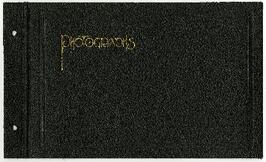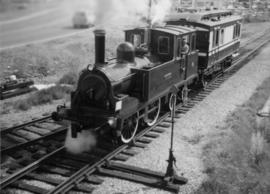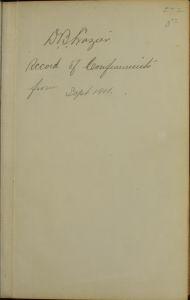The David Davies Railway Collection encompasses all facets of railway history specifically in the province of British Columbia and the Yukon territory. The collection consists of research material accumulated over the course of more than fifty years, and includes monographs, periodicals, articles, clippings, railway timetables, photographs, maps and plans, and excerpts. Material covers public, tourist, and private (industrial) railways, including: CPR, KVR, E&N; CNR, CNoR, GTPR; and PGER, BCR. The collection excludes material regarding streetcar systems and rapid transit, but includes long distance electric interurbans.
This journal by Dr. Lazier consists of his obstetric notes on pregnancies, childbirths, infant deaths, and maternal deaths during his practice from 1901 through 1918 and 1922 through 1930. Some of the locations and regions covered in the journal include: Prince George/Fort George and the surrounding area, Nakusp, Arrowhead, Beaton, Camborne, Princeton, Fraser Lake, Burns Lake, Grayson (Saskatchewan), Neville (Saskatchewan), Ranfurly (Alberta), Minburn (Alberta), etc. A few pages at the back of the journal consists of a child’s writing in pencil of a “list of made up words” and a list of “German words.”
Lazier, Dr. David BrownleeIn 1936, Gordon Young Wyness was employed by Philip M. Monckton, a B.C. Land Surveyor. Between June 5 and October 8, Wyness joined Monckton and a group of others on a land survey expedition in northwestern BC. The survey crew travelled to various locations in the area including Telkwa, Hazelton, Burns Lake, Francoise Lake, Vanderhoof, Prince George, Quesnel, Lytton, and Hope. Wyness documented their journey in this photograph album. Based on the photographs, it appears that the crew led by Philip Monckton consisted of Jack Lee and Gordon Wyness; Mrs. Lavender Monckton (nee O'Hara) also accompanied the group.
In addition to the 50 photographs included in the album, this collection also includes five additional unique photographs that accompanied the album.
Wyness, Gordon YoungThis collection encompasses the records of the eJournal "It's Still Winter: A Web Journal of Contemporary Canadian Poetry and Poetics", which was co-published online by College of New Caledonia and the University of Northern British Columbia between 1997 and 2002. The editors of the journal were Don Precosky and Barry McKinnon. The journal published the work of poets from across Canada, but the majority were from northern British Columbia.
The collection contains analogue reproductions of the eJournal issues, drafts and manuscript submissions to the eJournal, and digital records relating to the eJournal (including the website files for the online eJournal).
The item is a document created by the John Hopps Mining Property documenting various aspects of their mining operations. The document contains descriptions detailing the history of the discovery of gold in the Cariboo and the founding of John Hopp Mining Property. Information on the Property includes estimated earnings, estimated costs, cubic yards washed, ounce yields, value of yields, values per cubic yard, actual operating expenses, improvements, and profits over operating expenses for years 1907 to 1924. Photographs depict Stouts Gulch hydraulicing, Stouts Gulch to Lowhee Summit, Lowhee Ditch & Penstock facing Lowhee Stouts Gulch Summit, the new Lowhee Reservoir Dam construction, Lowhee Flume and Dump, Lowhee flume and pit, Mosquito Creek flume, cleaning bedrock at Mosquito Creek, the building at Willow River, Ella Reservoir Dam construction, the saw mill at Jack of Clubs Lake, Forest Rose flume, gold samples from Lowhee Stouts Gulch and Mosquito Creek. The maps depict claims, leases, etc. on Williams Creek, John Hopp mining properties in Barkerville District and British Columbia mining divisions in 1922. The ledger includes leaves, real estate placer claims, record placer claims, crown granted land, and water records for the John Hopp Mining Property.
The document was created to show the extent and operations of the Jonn Hopp Mining Property. The Property is known for its historical significance in gold mining in British Columbia during the 1920s.
John Hopp was a notable for his involvement in mining in the Wells-Barkerville area in the Cariboo region of British Columbia. He managed operations at Slough Creek Ltd., which included the first shaft house, first office and first bunkhouse. The John Hopp Mine at Lowhee Creek was named after him and was a significant gold producer.
The item contains photographs materials from 1868 to its publication in 1923.
This item covers over 55 years of mining operations, their value, and social and environmental impact in the Cariboo Region of British Columbia spanning 1868 to 1923.
John Hopp Mining Company

